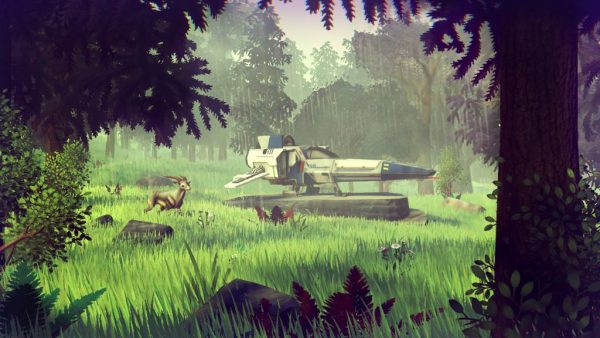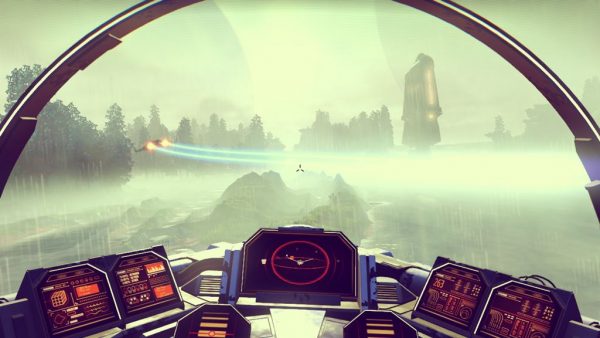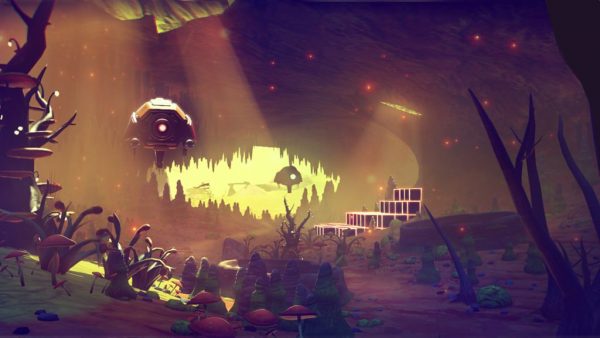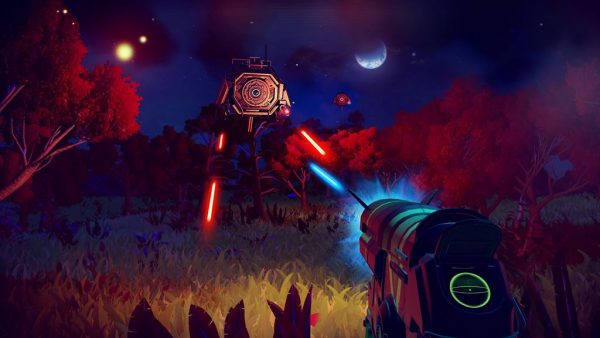Also On: PC
Publisher: Hello Games
Developer: Hello Games
Medium: Digital/Disc
Players: 1
Online: Yes
ESRB: T
No Man’s Sky was always going to be a tough game to review. On one hand, it appears to be nearly everything that Hello Games wanted it to be — and that is a near infinite sandbox of a universe with planets and star systems to discover and explore, alien life forms to make contact with, and mysteries to solve. On the other hand, if you’re the type of gamer who craves structure and an overarching narrative in your games (even in the open-world genre), then the part survival, part exploration concept in No Man’s Sky may be lost on you. Either way, No Man’s Sky is an intriguing sci-fi experience worth considering in you’re in the market for something a little different. Especially PS4 gamers.
Once you drop onto an undiscovered planet in a galaxy far, far away for the first time, and get beyond the basics and handholding (there’s just enough to get a player started, but not quite enough to explain some basic-yet-critical to understand mechanics), it’s up to each individual player to forge their own path in No Man’s Sky. With 18 quadrillion procedurally generated planets out there, there’s a heck of a lot of variety and the assumption that no two players will have exactly the same experience.
If you were expecting No Man’s Sky to be a massively multiplayer game, or at least one that offers a chance of bumping into other players during your interplanetary adventures, then you’re better off getting that idea out of your head. Even though Hello Games was semi-clear on No Man’s Sky being a online connected game with the community having a presence in the universe (discovering and naming planets, star systems, aliens and whatnot), there was seemingly never a hard promise of actual player interactions. Like it or not, at this point in time, it’s mostly you, alien lifeforms and non-player characters inhabiting the world of No Man’s Sky on your journey to the ?center of the galaxy?.
There’s more than a fair share of paths you can take in No Man’s Sky, and it’s generally a pretty chill experience. The landscapes, alien flora and fauna, and variety of atmospheric conditions found in each procedurally generated star systems’ planets and moons are undeniably impressive. Just taking a leisurely walk or flyover along the surface of any planet will yield lots of interesting sights and sounds — and danger, in the form of hostile sentinels, fantastic creatures, and inhospitable climate conditions. Whether or not you choose a path of passive explorer/trader or greedy aggressor, you’ll need to spend time scanning the planet for life, elements and equipment in order to survive (and hopefully thrive). This includes upgrading your suit, equipment and life support systems, enhancing your multi-tool and repairing/fueling/upgrading your ship, which is required to even leave the planet surface for the first time. Inventory management skills become critical early on, and your suit and ship only have a relatively meager amount of slots available for crafting and storage of materials and enhancements. While a few materials can be stacked, many cannot, which means you’ll run out of room very, very quickly, even with the ability to easily transfer between your ship and suit.
My 11 year old son is an avid Minecrafter, and can spend hours on end exploring, crafting, surviving and fiddling with inventory and resources in the many versions of the game available. He absolutely fell in love with No Man’s Sky and has eagerly put in more than 20 or so hours warping across the galaxy, discovering and scanning new planets and star systems, trading with aliens and upgrading equipment — and it appears he’ll be happy to do so for dozens more. What’s important is, he has patience for that type of experience, which is a trait that lends itself well to playing No Man’s Sky. With him as my co-pilot, and myself as his, we’ve put in more than enough time and effort to get a good handle on the game systems and mechanics, and discover and upload a plethora of extraterrestrial entities. Even with significantly beefed up equipment and transportation, we still only feel marginally closer to any sort of endgame or revelation however. There is something out there, and thus far we still feel compelled to find out what it is.
So here’s where the game will either click with you or it won’t. It requires time and patience, and the player being okay with making incremental progress on whatever they decide to do in the game. It’s seemingly more about the journey than the destination in No Man’s Sky, which isn’t a bad thing at all if you’re looking for something different. You just have to know what you’re getting into and not expect instant reward or payback every time you set aside some time to play the game. The game’s pace is decidedly slow and steady, so impatient types need not apply.
Being procedurally generated, the universe that exists in No Man’s Sky is surprisingly beautiful and well constructed. With a variety of star systems, each hosting a variety of celestial bodies, the visuals hold together very well. While the game never approaches the possible 60fps target that Hello Games once mentioned, it’s pretty solid 30fps experience. Players will have to deal with storms, day/night cycles which are influenced by orbits and rotations of the planets they are on, not to mention the changing temperament of autonomous and alien beings (assuming the planet is hospitable enough for them to be present). On the audio side, No Man’s Sky subscribes to the ?less is more? philosophy with dramatic thumping beats occasionally kicking in when there’s a little action, and letting ambient sounds and soothing tracks exist mostly in the background, otherwise.
No Man’s Sky controls well enough once you figure out the mechanics of the suit, multitool and ship. Combat (on foot and in space) is certainly not the game’s strongest system, but sometimes you are forced into it when there is no easy way to escape or avoid an encounter altogether. There are also definitely some times where you can work yourself into a bad situation, usually getting stuck in a cave that’s just a little too small, or in a pit, or leave your ship on top of a structure you shouldn’t, but with enough effort and time there’s usually a way to remedy the problem. If not, you’ll need to reload a previous autosave — which is most commonly triggered by entering and exiting your ship. If you do meet an untimely end, whether it be by hostile elements or weather, you are reincarnated back at your last save point and can seek out your dropped equipment without any real penalty. Hello Games thankfully doesn’t punish players for screwing up too much.
So circling back to the start of the review? I went into No Man’s Sky expecting that it would be somewhat difficult to review and grade. Co-playing the game with my son seemed to be the right route to take to get a better perspective on the massive, diverse science fiction sandbox and what to say about it. While it has some problems and may not be for everyone, Hello Games should be commended for pouring all their effort into such an ambitious project and launching an end product that fulfilled their vision. We’re excited to see how they plan on refining and improving the experience post-launch, but for now we’ll continue on our mysterious intergalactic journey.





